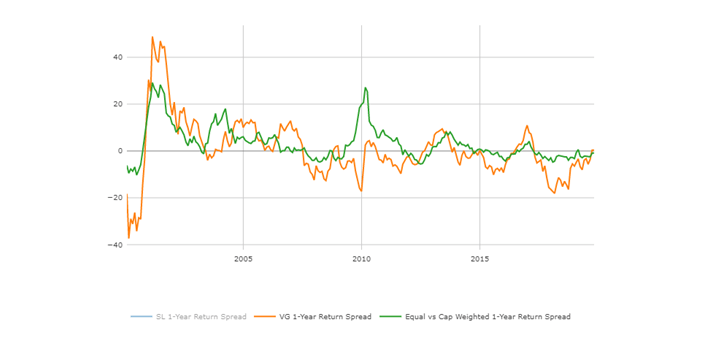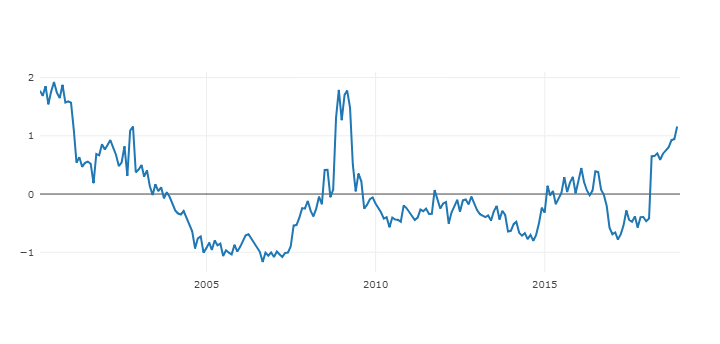Game of Chicken
Recent escalation in the trade war with further tariffs from China followed by further counter measures and additional tariffs from President Trump depressed equity markets around the globe. Professor Siegel described the additional Trump tariffs as Trump’s game of ‘chicken’—looking to see who will blink and veer off this tariff road first. We agree with Professor Siegel’s baseline view that both sides will come to some sort of an agreement, but that in the short-run, the markets are likely to stay volatile. If there is a trade deal, Professor Siegel sees a 10-15% pop higher in the equity markets.
US Economics
The US economy is humming along but the composition of US economic growth has changed. There is downward pressure from overseas, but more assistance from the Federal Reserve (in the form of a faster pace of interest-rate cuts) and resilient consumer spending. In the second half of the year we don’t have a clear direction of growth with industrial output slowing down, mixed housing activity, and blooming retail spending. This combination suggests the second quarter’s 2%+ GDP growth may become the growth rate for the next several quarters, before further slowdowns. Signet’s proprietary Macro Forecast for the most part flashes no significant recession signs other than the inversion in the yield curve. On its own, a flat yield curve is not a predicament of a future recession. On average after the yield curve flattens out, a recession follows in 18 months. However, that usually happened when the Fed was aggressively raising short-term rates – not relaxing them.
Global Economics
Per JP Morgan, a growth rotation is underway as we move through the current quarter. Although manufacturing and international trade remain weak, a tentative stabilization is taking hold. Projected globally, the PMI survey looks to have stabilized over the past three months at a level above the current pace of output growth. The latest readings out of Asia further support this view: upbeat July trade reports from Taiwan and Japan reinforce the belief that first half slowdown is fading away. However, while manufacturing stabilizes, weaker service sector and slower job growth started dragging the world economy. Nevertheless, manufacturing sector stabilization suggests that firms have adjusted sufficiently to the past year’s geopolitical uncertainties.
Corporate Profits and Stock Market
Corporate America is very healthy. Profits continue in a multi-year uptrend, but the historic advance in both earnings and revenue is flattening this year. However, we still see earnings routinely exceeding expectations. According to Value Line, in the second quarter 75% of the companies in the S&P 500 had positive earnings surprises; 57% did so on the revenue line. That is more or less in line with recent years. We also do not see this stock market overheating with the current P/E ratio for the S&P 500 around 17 – just nominally above the five-year average. Moreover, Signet’s actively managed portfolios tend on average to have P/E ratios 15-25% smaller than their related benchmarks. We continue to see decent profit projections for the coming quarters and expect a modest upward trajectory in earnings to continue in the coming quarters. We see this market supported by steady economic growth, subdued inflation, low interest rates, and healthy corporate earnings.
Crowded Market
The last few years the level of market concentration (market driven by very few mega caps) has been unprecedentedly long (see the chart below). According to Goldman Sachs, despite their substantial outperformance, these stocks also pose the greatest crowding risk, particularly for hedge funds. Across hedge funds, portfolio concentration has been growing, position turnover has been falling, and crowding has been rising. The average hedge fund holds 69% of its portfolio in its top 10 positions, compared with 57% 15 years ago. Mutual fund positioning is relatively less dense, both by nature of being bench-marked and by manager choice. The average large-cap mutual fund holds 36% of its portfolio in its top 10 positions, compared with 23% for the S&P 500. The combination of high portfolio concentration and crowding makes funds particularly vulnerable to a potential positioning unwind, especially if accompanied by a decline in liquidity. In fact, during risk-off events, funds often sell popular stocks first because they are more liquid, causing them to under perform.
Equal vs. Market Cap Weighted 1 Year Return Spread:
Changes to Our Portfolios
Here at Signet, we recently rebalanced our actively managed equity portfolios taking into consideration bullish Sector Forecast (especially Bottom up analysis) on one hand and a little more cautionary Macro indicators. We emphasized a bit more Safety, Quality, Profitability and Sustainable Momentum factors. Overall, we still favor cyclical Economic Sectors like IT, Industrials, Communication Services and Real Estate. As a precaution, we have added a bit to Utilities though. Our Large Cap and GARP (growth at reasonable price) posture didn’t change much from our previous rebalancing. More details and portfolio changes are available on our website in a recorded webinar.
The information and opinions included in this document are for background purposes only, are not intended to be full or complete, and should not be viewed as an indication of future results. The information sources used in this letter are: WSJ.com, Jeremy Siegel, PhD (Jeremysiegel.com), Goldman Sachs, JP Morgan, Empirical Research Partners, Value Line, Ned Davis Research, Citi research and Nuveen.
IMPORTANT DISCLOSURE:
Past performance may not be indicative of future results.
Different types of investments and investment strategies involve varying degrees of risk, and there can be no assurance that their future performance will be profitable, equal any corresponding indicated historical performance level(s), be suitable for your portfolio or individual situation, or prove successful.
The statements made in this newsletter are, to the best of our ability and knowledge, accurate as of the date they were originally made. But due to various factors, including changing market conditions and/or applicable laws, the content may in the future no longer be reflective of current opinions or positions.
Any forward-looking statements, information and opinions including descriptions of anticipated market changes and expectations of future activity contained in this newsletter are based upon reasonable estimates and assumptions. However, they are inherently uncertain and actual events or results may differ materially from those reflected in the newsletter.
Nothing in this newsletter serves as the receipt of, or as a substitute for, personalized investment advice. Please remember to contact Signet Financial Management, LLC, if there are any changes in your personal or financial situation or investment objectives for the purpose of reviewing our previous recommendations and/or services. No portion of the newsletter content should be construed as legal, tax, or accounting advice.
A copy of Signet Financial Management, LLC’s current written disclosure statements discussing our advisory services, fees, investment advisory personnel and operations are available upon request.



























































































